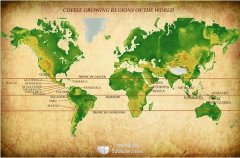Coffee Culture Boutique Coffee Bean World

And when they came to him thousands of years ago, he said,"O Lord! We are used to the idea that everyone is equal, of course, it sounds very pleasant, but if this sentence is placed on coffee beans, it is estimated that beans will jump out to express opposition: we all want to talk about origin! In our opinion, coffee beans are all small black charcoal. In the opinion of senior coffee expert Liang Chaoxiong, there are basically three species according to species, arabica, robusta and liberica, although there are as many as 40 species of coffee plants. Among them, Lobsta is the most important road. It belongs to lowland coffee, has strong disease resistance and the highest yield. It accounts for 60 to 70% of the coffee bean production in the market. It is found in Southeast Asia and West Africa. It is also high in caffeine, instant coffee, canned coffee on the most preferred it.
Arabica is a typical "high mountain flower", belongs to highland coffee, most of the fine coffee in this category, like blue mountain coffee powder in the hearts of the idol coffee, but also Arabica species. It appears in human history the longest time, it is said that the earliest coffee introduced from the Arab world to the Western world, is Arabica coffee. It is the only coffee that all native species can drink directly, but it has a fatal point is low disease resistance. Sri Lanka was once a famous coffee growing country. Because of a coffee leaf rust, all the Arabica coffee planted in the country went back to the west, and only black tea was planted gloomily. It can be found in South America, Central America, Africa and parts of Asia.
The least popular is Liberia, which is not as flavorful as Arabica and does not have a lot of money to invest in cultivation. It is usually only communicated among experts or used for research. Highland Coffee was superior to the other three coffee beans. Players were after Arabica beans. This is because highland coffee is superior to lowland coffee. Therefore, when commenting on coffee quality, the height of origin is often included in the evaluation criteria. The higher the altitude and the lower the relative temperature, the coffee fruit ripens slowly, so that the fully ripe beans swell well and are easy to roast. In coffee producing countries in Central and South America, the quality of coffee beans is basically evaluated only by the altitude of origin. As for specialty coffee, it's all highland coffee. Of course, if you play more professionally and intensively, most of you will also see whether the coffee has organic certification. The players will recognize: USBA certification, rainforest certification, fair trade certification. Giving coffee beans a second life roasting is equivalent to finishing the coffee beans. The flavor of coffee beans themselves is hidden, and only moderate roasting can seduce its flavor, just as dry firewood needs fire.
According to experts, 80% of the factors that determine the taste of coffee come from green beans and 20% depend on roasting. Roasting is divided into three types: deep, medium and shallow. There is no difference between these three roasting methods. It depends on what kind of roasting method the coffee beans themselves are suitable for. The key lies in the roasting method. If the technique was wrong, even the best beans would be destroyed. The hardest part about roasting coffee is the best time to stop, depending on how the roaster captures the characteristics of the beans. This is determined by experience, by noticing changes in temperature, color, sound, aroma, shape, and luster of the beans.
All coffee contains bitter and sour tastes. In general, the lighter the roast, the more sour the coffee. The deeper the roast, the stronger the bitterness. Deep roast for coffee with strong acidity. Light roasting, on the other hand, is suitable for bitter coffees, allowing acidity to be released, easing excessive bitterness and balancing flavors. However, coffee has an expiration date for drinking, no matter how high the roasting method, drink it within two weeks after roasting, otherwise the flavor will be greatly reduced. After the extract of the deciding game has undergone correct picking, production and baking, it comes to the last two passes of import, grinding and extraction. These two processes are complementary. The fineness of the powder determines the way coffee is extracted. In general, fine powder is the easiest to extract the essence, so it takes the shortest time, usually with 90 degrees Celsius water quickly after extraction, with Italian machine and mocha pot.
Moderately ground words, usually the family drink, to preheat coffee cups and coffee pots, so that the coffee aroma is more prominent, generally 85 degrees Celsius to 90 degrees Celsius water temperature, mainly hand flushing pot, drip pot and siphon pot. As for the coarse powder, it is necessary to use a French pressure pot, which requires the longest extraction time and the water temperature is also between 85 and 90 degrees Celsius. The standard of good coffee Although there are a lot of professional terms used to judge coffee, which can be comparable to red wine, in fact, they can all be ignored, and your tongue is the first judge. Mr. Liang said that if it is really good coffee, it is actually very simple: it tastes comfortable, clean, no impurities, pure aroma, and of course the most important thing is that the coffee beans should be fresh. If left for a year and a half, Xi Shi would become a bell without beauty.
Important Notice :
前街咖啡 FrontStreet Coffee has moved to new addredd:
FrontStreet Coffee Address: 315,Donghua East Road,GuangZhou
Tel:020 38364473
- Prev

A brief introduction to the traditional coffee drinking methods of the famous Ten Kingdoms
1. Italy: it is a kind of espresso in a small cup, which can be cooked and drunk quickly. People who have been in contact with the coffee for a long time can get used to its heavy taste. 2. France: the French prefer light coffee, which is generally made from moderately roasted and roughly ground coffee beans by soaking. I like to drink it with chicory root. 3. UK: coffee is usually put
- Next

Introduction to the origin of boutique coffee in Africa
1. Kenya Kenya grows high-quality Arabica coffee beans, which absorb almost the essence of coffee cherries, with a slightly sour, thick aroma, and are very popular among Europeans, especially in the United Kingdom. Kenyan coffee surpassed Costa Rican coffee and became one of the most popular coffee. With aromas of wine and flowers, the texture is full, small and round, because
Related
- Beginners will see the "Coffee pull flower" guide!
- What is the difference between ice blog purified milk and ordinary milk coffee?
- Why is the Philippines the largest producer of crops in Liberia?
- For coffee extraction, should the fine powder be retained?
- How does extracted espresso fill pressed powder? How much strength does it take to press the powder?
- How to make jasmine cold extract coffee? Is the jasmine + latte good?
- Will this little toy really make the coffee taste better? How does Lily Drip affect coffee extraction?
- Will the action of slapping the filter cup also affect coffee extraction?
- What's the difference between powder-to-water ratio and powder-to-liquid ratio?
- What is the Ethiopian local species? What does it have to do with Heirloom native species?

